What Every Cat Owner Should Know About Dental Care For Cats
Dental disease is a reality for most cats. By age four, many cats have significant gingivitis and many also have periodontal disease. It is a slow progressing but serious disease that causes pain and affects the overall health and wellbeing. Cats will not show signs of oral discomfort. Because the pain associated with dental problems comes on slowly over time, they simply learn to live with it. That is why it is important that all cats see a veterinarian annually to assess their oral health.
Featured Quote:
Video Transcript:
This is a one-year old male, castrated domestic short-hair cat. He's here for dental therapy today. As you can see he has a little gingivitis and tartar accumulation. We just did the blood work and we're ready to put him under anesthesia to do dental therapy. He's getting oxygenated to get ready for the anesthesia.
He is under anesthesia right now and his vitals are monitored very closely with this machine. EKG, Pulse Ox; which is the oxygenation level, the capnography; which checks for the CO2 level, are all checked on this machine. We’re about to start the cleaning and we will be constantly monitoring anesthesia.
We then take four dental x-rays. After a thorough cleaning by the nurse we assess the periodontal space with a periodontal probe. This cat’s periodontal space looked healthy so we did not have to do any further treatment for the periodontal space. Now we're going to look at the x-rays to assess the remaining oral health.
Now we're going to assess his radiographs to make sure everything's okay. The crown of cats and dogs is a case of about 40% of the teeth that you could see and 60% is under the bone so x-rays are very helpful to look at the entire health of the teeth and his x-rays look really nice.
Now we're going to apply SANOS, which is a gingival dental sealant for dogs and cats that seals the gingival sulcus; which is the space between the gum and the teeth, against the formation of plaque. It works for six months and we highly recommend it but this is an optional treatment.
What Is Proper Dental Hygiene For Your Cat's Teeth?
There are several ways to ensure proper cat dental care. All of them involve diligence and commitment from you as a cat owner. Your feline friend will not tell you if he or she needs dental care, so it is up to you to proactively address their needs.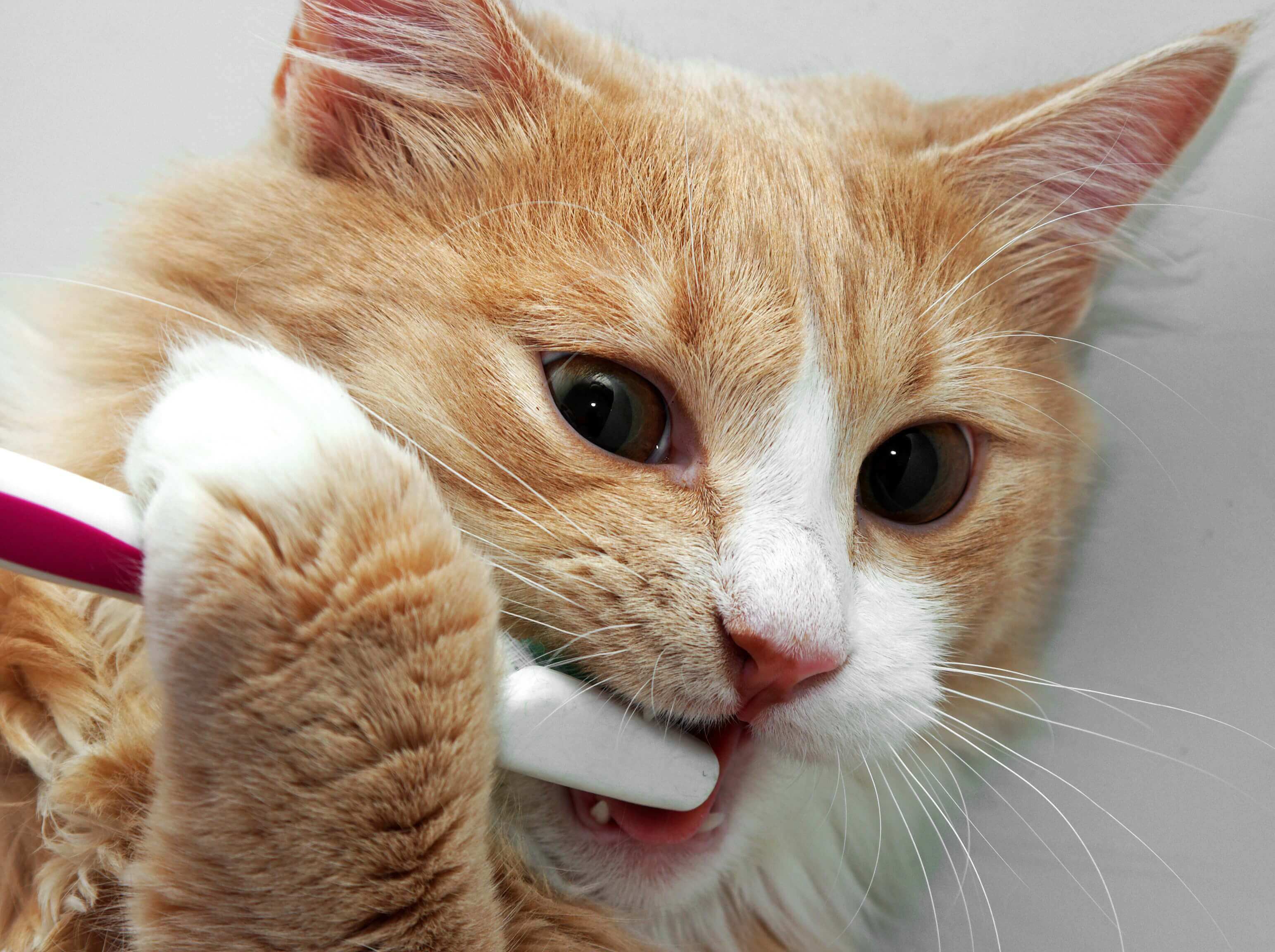
- Good nutrition is the foundation for good dental health
- When possible establish a cat teeth cleaning routine when your cat is young
- Schedule semi-annual exams for cats
- Watch for signs of possible dental issues such as bad breath
- Tell your vet during the checkup about any behaviors you've noticed, or concerns you have
- Early prevention is extremely important to avoiding or treating serious dental issues
Proper cat teeth cleaning consists of an oral exam and x-rays under anesthesia in order to properly diagnose any dental disease that may be present. Most of the dental disease in cats is under the gum line. Many cats produce feline odontoclastic resorption lesions (FORL) in their teeth. These are cavity like lesions at the neck of the tooth (where the gum meets the tooth). These lesions cause the roots to be resorbed. These lesions are painful. Unfortunately, your cat will naturally adapt to live with the pain these lesions cause. In these cases, the treatment usually requires extraction of the affected tooth/teeth. Not all cats are plagued with feline odontoclastic resorption lesions (FORL). Only a thorough exam involving x-rays taken by your vet can determine if your cat is living with these lesions. Treatment is curative. However, cats who produce these lesions are likely to produce more in their lifetime and will require annual care.
Other dental issues in cats include gingivitis and periodontal disease that may require medication and or dental work to alleviate the pain. The importance of annual exams cannot be underestimated. In order to remain healthy, dental care is something you should trust to your veterinarian.
How Often Is It Necessary To Clean A Cat's Teeth?
The recommended frequency of cleaning your cat's teeth depends upon several factors such as:
- age
- genetics
- diet
- lifestyle
- existence of other health conditions
Regardless of signs or symptoms, your cat should have a dental checkup annually at a minimum. While you should be looking at your cat's teeth periodically yourself, it is easy to miss the types of problem signs that a trained and experienced veterinarian will pick up on. It is significantly easier to address and resolve dental issues that are spotted early, compared to dental issues that go unnoticed and are allowed to further develop. Therefore, a proactive approach to feline dentistry is recommended.
Many cats will allow you to brush their teeth. You should brush your cat's teeth daily with specially designed brushes and feline hygiene products. Our technicians are trained to provide instructions on how you can brush your cat's teeth at home. Let us work with you to ensure the best possible dental health for your cat.
Before:
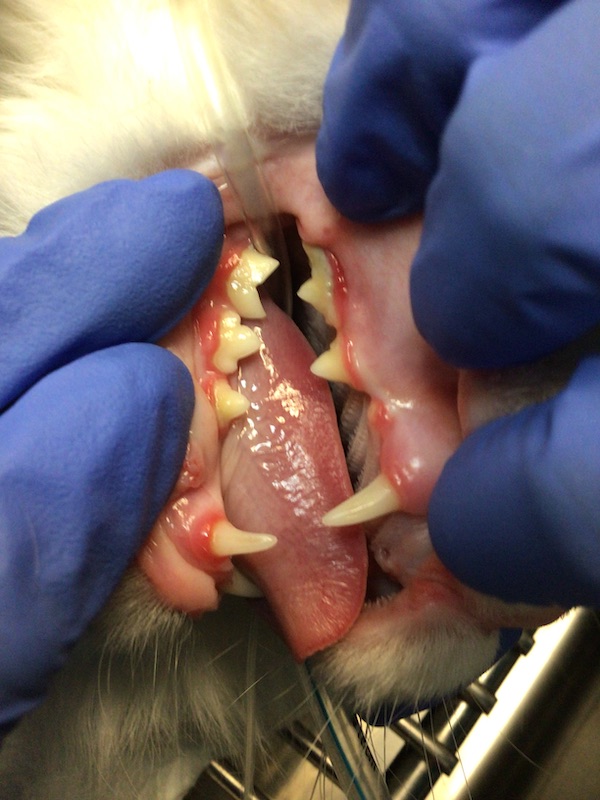
After:
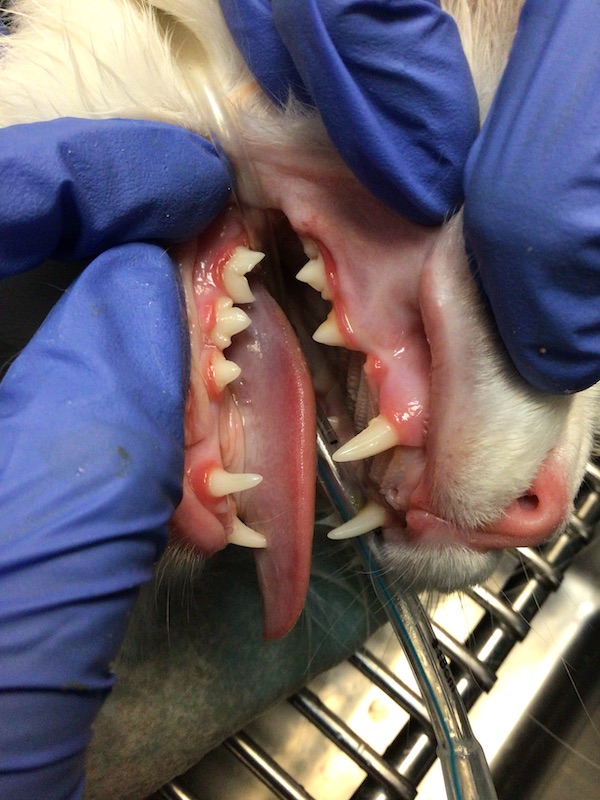
Before:
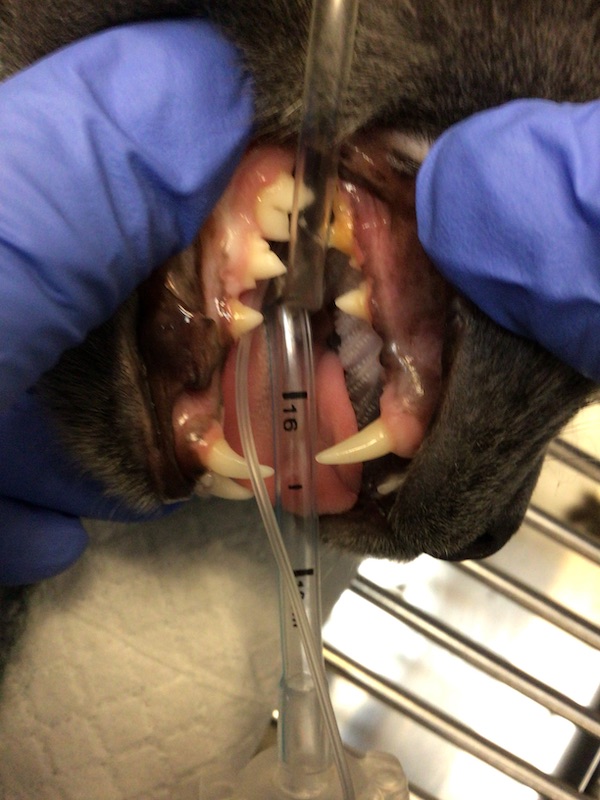
After:
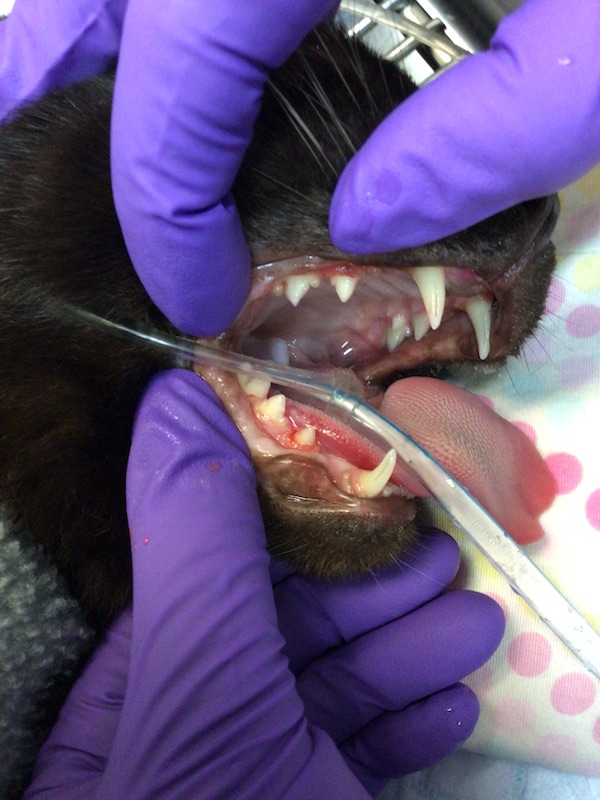
Gum Disease In Cats
Gum disease, also known as gingivitis and can become periodontal disease if it spreads into the tooth. These conditions affect a cat's gums and the portions of their teeth below the gum line and may include feline odontoclastic resorption lesions (FORL). Periodontal disease is considered the most prevalent illness in cats over three years of age. However, it is also the most under diagnosed, because many cat owners unfortunately just do not realize the importance of cat dental care. Although detection of cat gum disease can be subtle, periodic veterinary checkups every 6-12 months can be effective in helping diagnose cat gum disease before it becomes severe.
Gum disease has four stages:
- Early gingivitis
- Advanced gingivitis
- Early periodontitis
- Established periodontitis
Gum disease in cats is only reversible if caught early on, and only the early gingivitis stage is considered fully reversible. Therefore, it is your responsibility to keep your cat's mouth, teeth and gums healthy and well.
Cat Tooth Extraction
Cat tooth extraction is necessary in several cases, including advanced stage gum disease. Advanced periodontal disease can cause loss of viable teeth. The teeth that are severely affected should be extracted before the damage is permanent.
Other reasons for cat tooth extraction include:
- Retained deciduous or maloccluded teeth are less common causes for extraction
- Dental caries, FORLs or teeth that are severely infected are always considered for extraction
- Cats that suffer from root abscess
The cost of cat tooth extraction is based on the type of procedure performed, and may include hospitalization, anesthesia, painkiller medication, x-rays and surgical supplies. Therefore, it's best to always take preventive measures to avoid surgeries and cat tooth extraction procedures.
Common Cat Dental Problems
- Plaque build-up
- Gingivitis
- Periodontal disease
- Tooth loss
- Mouth sores and ulcers
- Feline Odontoclastic Resorptive Lesions (FORL)
- And, like in humans, kidney, liver, and heart disease
Cats are very adept at hiding symptoms of pain and illness. Bad breath is the only symptom of dental problems that you are at all likely to observe in your cat. If your cat has noticeable bad breath, you should schedule a dental exam with your veterinarian. However, in severe cases you may also notice one of the following symptoms:
- Pawing at the mouth
- Drooling
- Problems eating, loss of appetite
- Red, swollen, bleeding gums
- Loose, broken, missing teeth
- Blood in saliva or nasal discharge
- Lesions in mouth
Your cat may very well have dental issues that require attention and NOT show any of the symptoms listed above. However, if any of the above symptoms are observed, please schedule a veterinary appointment right away.
Schedule A Cat Dental Care Appointment
Scheduling a cat dental care appointment is as easy as picking up the phone, or sending us an email. Our staff is here to help make your trip to the dentist easy for you, while making it as painless and comfortable for your feline friend as possible.
